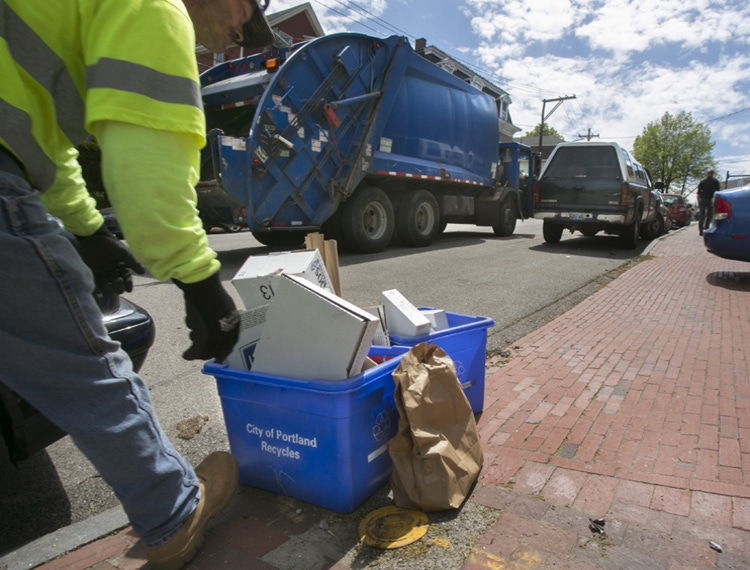April 27, 2017

As more cities begin to leverage circular economy principles to reach ambitious zero waste goals, ensuring that packaging is both "recoverable" and "recovered" will be hallmarks of any successful plan. In recent years, cities have become bolder in categorically banning or mandating certain packaging types in attempts to match what packaging is being sold or distributed and what a given city’s recycling and composting systems can currently process.
The first wave of city-led packaging bans largely honed in on foam (expanded polystyrene or EPS), perceived by many cities as a problematic packaging substrate due to the confluence of several factors. Namely, less than 20% of Americans have access to recycling infrastructure for EPS, and yet we see a high incidence of EPS packages and EPS microplastics in marine environments. After a few of early outliers, more than 96 distinct city ordinances have banned EPS since 2008.
However, in the last few years, several cities have changed tack in approaching packaging requirements. Though straight-forward bans are still being implemented in many areas, cities like Washington, D.C., Seattle and Minneapolis have gone a step further and passed ordinances that deem recyclable and compostable packaging compliant and non-recyclable or -compostable packaging non-compliant. While common in Europe, this tactic is certainly more progressive for American cities. The practice of more hands-on specifications for packaging has even permeated national governments in Europe, led by France mandating that all single-use food serviceware be home compostable by 2020.
Yet, the compliant and non-compliant packaging established by Seattle, D.C. and Minneapolis paint packages with broad strokes. In terms of compliant packages that are recyclable, Minneapolis categorizes “glass bottles, aluminum cans and some plastic food and beverage packaging” as recyclable and names polyethylene terephthalate (PET), high-density polyethylene (HDPE) and polypropylene (PP) as preferred plastics since robust markets exist. In a similar, but slightly more specific way, the Mayor’s List of Recyclables and Compostables for D.C. considers packaging to be recyclable if “made solely out of one of the following resin types”: PET, HDPE, LDPE, PP and PS.
Overall, it’s exciting to see cities start to curate packaging that’s sold or distributed to match the local recycling infrastructure and note the importance of strong end markets. But, needless to say, just because a package is made of a recyclable resin, problematic colorants, inks, fillers, labels, adhesives, additives, barrier layers or closures could render a given package unrecyclable according to the Assn. of Plastics Recyclers’ Design Guide. Even though PET has a strong end market, for instance, if a PET package is opaque, it dramatically reduces the resale value and is considered detrimental to recycling by APR.
Among the compostable packaging sections of these packaging ordinances, there are big differences in how comprehensively each addresses compostability. For instance, some city packaging ordinances strictly govern packages and consider the many incidental items that are associated with food serviceware to be out of scope.
Minneapolis, for one, exempts utensils and straws from its Environmentally Acceptable Packaging Ordinance as “they are not packaging items.” The California county of Santa Cruz, on the other hand, is much more comprehensive in its Environmentally Acceptable Packaging Materials Ordinance, which went into effect on Jan. 1, 2017. Santa Cruz illustrates in its guideline for restaurants that plastic straws and plastic stir sticks are unacceptable and that “all to-go cutlery must be certified compostable.”
For composters, a more holistic view is critical in mitigating contamination of post-consumer pick-ups. Principal and managing director of the Compost Manufacturing Alliance, Susan Thoman, elucidates that “With all the best intentions, foodservice operators often spend time and effort procuring compostable serviceware, only to substitute what they may believe to be incidental non-compostable components to go with them.”
Thoman further explains, “For instance, when appropriate compostable hot or cold cups are sourced, yet the straws and lids used with them are not compostable, the entire set is tossed into the compost collection bin, creating a significant source of contamination for the compost facility.”
Justen Garrity, founder and president of Baltimore-based Veteran Compost echoes Thoman’s thoughts, lamenting that plastic straws and stirrers are Veteran Compost’s most challenging contaminants. While Veteran Compost regularly works with clients to use compostable serviceware, they have had to force the issue when plastic straws have persisted in the organics stream.
Municipality packaging ordinances are generally thorough in detailing compostable items that are within scope, however. St. Louis Park, MN, for example, communicates on its Public Works website that “Unfortunately many paper foodservice items are lined with plastic, so without a marking that it is compostable or other indication it is not lined, these items should go in the trash.” Moreover, the Minnesota city provides a phone number for residents to ask specific questions and encourages residents to look for signage or to ask restaurant staff. All of these strategies help prevent contamination and stimulate opportunities for further education.
Minneapolis and D.C. also demonstrate important attention to consumer education. Minneapolis’ online program materials explain why terms like degradable, biodegradable, oxo-degradable, and earth friendly are unreliable and don’t mean the same thing as compostable. D.C., on the other hand, draws attention to the fact that, while foodservice operators will have to comply with their ordinance and use BPI Certified packaging starting Jan. 1, 2018, there will be a separate acceptance list for compostable materials for all other entities and people once collection services are established in the District. This works to preempt confusion for residents who could mistakenly assume their requirements would match that of commercial foodservice operators in the near term.
D.C. also qualifies its Mayor’s List of Recyclables and Compostables by noting that “In the future, additional product and material types and processing types may be added to the list of what is required to be recycled.”
In lieu of the outright ban of yesteryear, these packaging ordinances allow cities to have more flexibility and adapt to changing technologies and innovations that increase recyclability of certain packaging types in the future. St. Louis Park’s ordinance even calls out a mandate to review what packages are acceptable annually. The St. Louis Park ordinance, which was passed unanimously by the City Council, is supported by one resident who clarifies that “If we just pick on polystyrene, we’re really not talking about zero waste.”
With pushback an undeniable consequence of these changes, increased costs will likely arise for businesses selling or distributing food serviceware. But Sue Sanger, a Councilmember of St. Louis Park, underscored that, in reality, these businesses are currently “off-loading their costs” and that “They may be saving a little money, but the environment is paying the price and frankly the taxpayers are paying the price. Taxpayers are funding the incinerators, the landfills and so on.”
While local businesses in Sanger’s area will only have months to comply for most packaging types, some exemptions are in place for small portion cups and PS lids for the time being.
Elsewhere, we can expect cities to reduce the quantity of exemptions and shorten the time periods that using non-recyclable or compostable packaging is tolerated.
Indeed, as more cities move closer to 2020, 2025 and 2030 zero-waste goals, it is likely that other cities will adopt packaging ordinances similar to those of D.C., Minneapolis and St. Louis Park. And, those that have already adopted packaging ordinances will, without a doubt, continue to tighten and refine what it means to achieve compliance.
Hopefully, second-generation packaging ordinances will provide clarity where the pioneering ordinances were vague. Including food serviceware incidentals like straws, utensils and stir sticks will make palpable differences in composters’ operations. And, getting more granular with what constitutes a recyclable package will go far in ensuring that recyclers are able to collect the highest-value materials that sort and reprocess correctly. In both cases, the bottom lines for composters and recyclers would improve.
As cities are hoping zero-waste achievements will be lasting solutions, ensuring recyclers and composters have strong business models is a fundamental that must be remembered.

Charlotte Dreizen, now a project associate for the Sustainable Packaging Coalition, joined GreenBlue as an intern in March 2016, focusing on the development of compost-related programs. Assisting with the creation of the Sustainable Composting Collaborative and research efforts to quantify the value of compostable packaging, she contributes experience from leading food waste research efforts, as well as supporting residential and higher-ed composting programs.
******************************************************************************
Learn about the latest developments in sustainable packaging at PackEx Toronto 2017 (May 16-18; Toronto, Ontario, Canada). Register today!
About the Author(s)
You May Also Like


